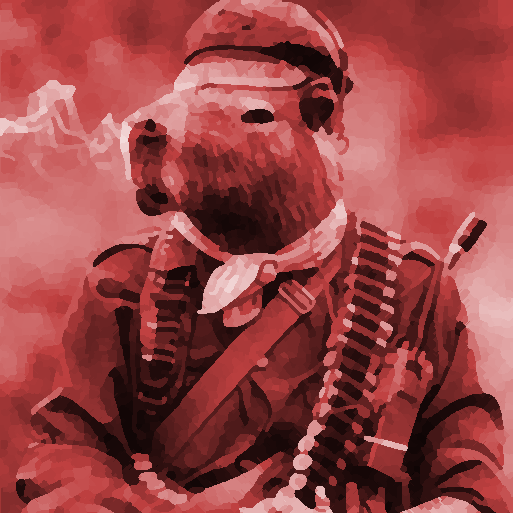This text was originally written by Marx and published in 1849, and was updated by Engels almost half a decade later, after the death of Marx. The text is an introduction to capitalism and overlaps with parts of Capital. You can read the text here.
You can post questions or share your thoughts at any time, even after we’ve moved on to a new text.
Suggest upcoming texts here.
Previous texts
I’ve been thinking a lot about the point that capital is incapable of producing value on its own and that only labor can create new value. Capital like tools, machines, etc. just transfers the value it holds due to past labor, while living labor is the only possible source of surplus value.
But I’m wondering how this principle holds up under the (potential, eventual) development of advanced AI. The question is more about how the theory would explain a capitalist society which had achieved true “abundance” and post-scarcity, even without solving the distribution problem and it’s not meant to imply that I believe these capabilities are right on the horizon or anything, but if we assume they exist it can help to understand the theory a little bit better, I think.
If a neural network could carry out intellectual tasks like writing, coding or creative work and if robots could carry out physical ones the what does the labor theory of value look like at that limit point? Is AI just dead labor like other machines, or is there (theoretically) something qualitatively different at that end point?
Can AI ever create surplus value in the Marxist sense? And if not, what are capitalists extracting when they profit from these theoretical fully AI-based supply chains?
Full automation without workers involved at all (including for repair and maintenance) would be an entirely different economic system, with different economic classes, and the LTV would need to be adapted accordingly. It would raise questions about the new role of the former workers (e.g. what would be the point in having a now-unnecessary exploited class, and how they could be suppressed?). Perhaps the value would be determined based on the amount of dead human labour required for the AI “workers” to function (assuming no natural resources are expended), but I can’t imagine such a system emerging from a capitalist base.
Would the value not come from the labor put into the training data?
Exactly.
Capitalism is incapable of achieving post scarcity because there would no longer be any profit. Without profit the bourgeoisie would no longer have a monopoly on capital.
This is a good reading for newer comrades who want to be more effective at agitation in the work place. It just gets to the core of what is wrong with the capitalist system. It doesn’t hint at any way of fixing things which I think is really good for agitation purposes where the goal is just to get people riled up and angry at the capitalists.
It’s a short but very dense read, I’m always impressed by how much knowledge Marx could cram in just a couple of pages. Some highlights:
What are Wages?
What they actually sell to the capitalist for money is their labour-power. This labour-power the capitalist buys for a day, a week, a month, etc. And after he has bought it, he uses it up by letting the worker labour during the stipulated time. (…) Labour-power, then, is a commodity, no more, no less so than is the sugar. The first is measured by the clock, the other by the scales.
Their commodity, labour-power, the workers exchange for the commodity of the capitalist, for money, and, moreover, this exchange takes place at a certain ratio. (…) Therefore, actually, the worker has exchanged his commodity, labour-power, for commodities of all kinds, and, moreover, at a certain ratio.
The exchange value of a commodity estimated in money is called its price. Wages therefore are only a special name for the price of labour-power,
Long before the cloth is sold, perhaps long before it is fully woven, the weaver has received his wages. The capitalist, then, does not pay his wages out of the money which he will obtain from the cloth, but out of money already on hand. (…) With a part of his existing wealth, of his capital, the capitalist buys the labour-power of the weaver in exactly the same manner as, with another part of his wealth, he has bought the raw material—the yarn—and the instrument of labour—the loom.
But the putting of labour-power into action—i.e., the work—is the active expression of the labourer’s own life. And this life activity he sells to another person in order to secure the necessary means of life. His life-activity, therefore, is but a means of securing his own existence. (…) Life for him begins where this activity ceases, at the table, at the tavern, in bed. The 12 hours’ work, on the other hand, has no meaning for him as weaving, spinning, boring, and so on, but only as earnings, which enable him to sit down at a table, to take his seat in the tavern, and to lie down in a bed.
the worker, whose only source of income is the sale of his labour-power, cannot leave the whole class of buyers, i.e., the capitalist class, unless he gives up his own existence. He does not belong to this or that capitalist, but to the capitalist class; and it is for him to find his man—i.e., to find a buyer in this capitalist class.
The same general laws which regulate the price of commodities in general, naturally regulate wages, or the price of labour-power. (…) within the limits of these fluctuations the price of labour-power will be determined by the cost of production, by the labour-time necessary for production of this commodity: labour-power.
the shorter the time required for training up to a particular sort of work, the smaller is the cost of production of the worker, the lower is the price of his labour-power, his wages. (…) In the same manner, the cost of production of simple labour-power must include the cost of propagation, by means of which the race of workers is enabled to multiply itself, and to replace worn-out workers with new ones. The wear and tear of the worker, therefore, is calculated in the same manner as the wear and tear of the machine.
The wages thus determined are called the minimum of wages. This minimum wage, like the determination of the price of commodities in general by cost of production, does not hold good for the single individual, but only for the race. Individual workers, indeed, millions of workers, do not receive enough to be able to exist and to propagate themselves; but the wages of the whole working class adjust themselves, within the limits of their fluctuations, to this minimum.
Relation of Wage-Labour to Capital
The labourer receives means of subsistence in exchange for his labour-power; the capitalist receives, in exchange for his means of subsistence, labour, the productive activity of the labourer, the creative force by which the worker not only replaces what he consumes, but also gives to the accumulated labour a greater value than it previously possessed. The labourer gets from the capitalist a portion of the existing means of subsistence. For what purpose do these means of subsistence serve him? For immediate consumption. But as soon as I consume means of subsistence, they are irrevocably lost to me, unless I employ the time during which these means sustain my life in producing new means of subsistence, in creating by my labour new values in place of the values lost in consumption. But it is just this noble reproductive power that the labourer surrenders to the capitalist in exchange for means of subsistence received. Consequently, he has lost it for himself.
Capital therefore presupposes wage-labour; wage-labour presupposes capital. They condition each other; each brings the other into existence. (…) Capital can multiply itself only by exchanging itself for labour-power, by calling wage-labour into life. The labour-power of the wage-labourer can exchange itself for capital only by increasing capital, by strengthening that very power whose slave it is.
The more quickly the capital destined for production—the productive capital—increases, the more prosperous industry is, the more the bourgeoisie enriches itself, the better business gets, so many more workers does the capitalist need, so much the dearer does the worker sell himself. The fastest possible growth of productive capital is, therefore, the indispensable condition for a tolerable life to the labourer.
To say that the interests of capital and the interests of the workers are identical, signifies only this: that capital and wage-labour are two sides of one and the same relation. The one conditions the other in the same way that the usurer and the borrower condition each other.
If capital grows, the mass of wage-labour grows, the number of wage-workers increases; in a word, the sway of capital extends over a greater mass of individuals.
Profits can grow rapidly only when the price of labour—the relative wages—decrease just as rapidly. Relative wages may fall, although real wages rise simultaneously with nominal wages, with the money value of labour, provided only that the real wage does not rise in the same proportion as the profit.
If, therefore, the income of the worker increased with the rapid growth of capital, there is at the same time a widening of the social chasm that divides the worker from the capitalist, and increase in the power of capital over labour, a greater dependence of labour upon capital.
The greater division of labour enables one labourer to accomplish the work of five, 10, or 20 labourers. (…) The labourers compete not only by selling themselves one cheaper than the other, but also by one doing the work of five, 10, or 20; and they are forced to compete in this manner by the division of labour, which is introduced and steadily improved by capital.
Furthermore, to the same degree in which the division of labour increases, is the labour simplified. The special skill of the labourer becomes worthless. He becomes transformed into a simple monotonous force of production, with neither physical nor mental elasticity. His work becomes accessible to all; therefore competitors press upon him from all sides.
The labourer seeks to maintain the total of his wages for a given time by performing more labour, either by working a great number of hours, or by accomplishing more in the same number of hours. Thus, urged on by want, he himself multiplies the disastrous effects of division of labour. The result is: the more he works, the less wages he receives. And for this simple reason: the more he works, the more he competes against his fellow workmen, the more he compels them to compete against him, and to offer themselves on the same wretched conditions as he does; so that, in the last analysis, he competes against himself as a member of the working class.
Neat. I’ll give this a shot.
Is the rate of profit equal to the bourgeois term return on investment? They have different definitions: Rate of profit - Profit per time over total capital, Return on investment - Profit per time over capital investment by a particular entity. It feels intuitively like they should be equal, but I’m not sure. The reason I ask is because it’s much easier to find data on return on investment. Thoughts?
I think they aren’t exactly the same. Return on investment is more of a financial term, and can be applied to anything, like buying and then selling houses, trading stocks, and even in the case of corporate finance, the returns of a marketing campaign, and the returns of a specific project. Profit is usually referred to a company’s earnings over a window of time, considering all costs, all revenue. Profit does not necessarily need an investment, it is the result of the reproduction of capital itself. Profit can be achieved from the company’s working capital, without necessarily needing a new investment.
Profit does not necessarily need an investment, it is the result of the reproduction of capital itself. Profit can be achieved from the company’s working capital, without necessarily needing a new investment.
This is wrong, the process of capital reproduction is seen as M-C-C’-M’, its a process of constant investment and profit, the rate of profit being the delta between M-M’. Investment doesn’t have to be external to be considered investment. So yeah rate of profit = return of investment, its just different jargon.
The simplest process possible may be M-M’, think of a credit where one lends money and expects money+interest back, interest being straight up the rate of profit/ROI. Maybe a robbery would be simply M’, and still i think there is some degree of investment on a robbery.
No, you are confusing things. You are confusing corporate finance terms with terms used by Marx’s analysis of the reproduction of capital. Marx is not concerned with corporate finance terms since the scope of analysis is very different, since finance and economics (actually political economy) are different (albeit related) disciplines.
ROI is usually tied to financial assets, for example stocks. So if I invest $100 in stock X and after 1 year they are worth $300, and paid $50 as dividends, then my ROI is 250%. ROI can also be calculated over any kind of investment, be it real estate, stocks, bonds etc. ROI inside of a corporation can also be calculated over a project or over a market campaign. Note that ROI may or may not be tied directly to surplus value, as one can have ROI without any labor involved, such as in case of a marketing campaign increasing product visibility, or a house increasing in price over time. I say directly because in the macro level, all capital gains are the result of surplus value (all things in the end are either extracted from workers or paid by workers), but this is not always true in the micro level.
A company’s profit (usually calculated based on a fiscal year), is basically all revenues minus all expenses. From the expenses, you need to count all inputs, wages, rent, maintenance, fees, capital expenses, taxes etc. Revenue includes capital gains (from investment in bonds, for example) and sales, which are directly tied to the production process. Note that a company’s profits are more aligned with the idea of the circuit of capital that Marx describes, since it’s related to an actual production process over a window of time.
ROI and profit can coincide in a sense that a capitalist invested $10000 in a new company and over 5 years it returned to him $20000 in net profit (summing up net profit from all 5 years), having a ROI of 100% over that time period. But only in such situations, since the terms mean different things.
It is the same thing yes.
they sound like the same to me. P.S. someone correct me if i am wrong.
“At the most, he could sell his future labour – i.e., assume the obligation of executing a certain piece of work in a certain time. But, in this way, he does not sell labour (which would first have to be performed), but not for a stipulated payment he places his labour-power at the disposal of the capitalist for a certain time (in case of time-wages), or for the performance of a certain task (in case of piece-wages). He hires out or sells his labour-power. But this labour-power has grown up with his person and is inseparable from it. Its cost of production, therefore, coincides with his own cost of production; what the economist called the cost of production of labour is really the cost of production of the labourer, and therewith of his labour-power. And, thus, we can also go back from the cost of production of labour-power to the value of labour-power, and determine the quantity of social labour that is required for the production of a labour-power of a given quantity, as Marx has done in the chapter on “The Buying and Selling of labour Power.” [Capital, Vol.I]”
I don’t quite get the difference.
The difference between what? Labour and labour power?
Yes, exactly.
Labour can’t be sold – once labour has been performed, there’s nothing left to pay for. What’s actually sold is labour power – the capacity to perform labour for some amount of time, i.e. a promise of future labour.
Ackchyually, usually the price of labor power is first haggled, then performed, and then paid. Nobody’s ever paid me for my labor in advance, though it’s known to happen on occasion.
Yes, the payment for labour power is usually determined in advance and paid after it’s been “consumed”. You are effectively giving the capitalist interest-free loans.
Labour-power is the ability one has to perform labour.
So it’s your ability. Gotcha. And if you’re disabled, you may be possibly lacking in labor power.
Started reading rn






